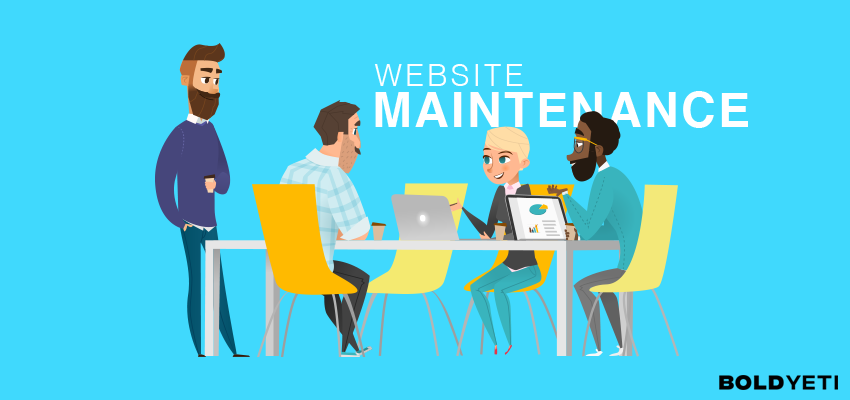
Website Maintenance Definition, Process, & Cost
Thriving online businesses do one thing exceptionally well: Website Maintenance.
You would never think twice about having your car serviced on a quarterly basis. Why don’t we do the same with our websites? After all, a website acts as your digital storefront and your best salesperson. More often than not, business owners wait until something is broken before getting it fixed.
So, what is website maintenance?
Your website is just like any other piece of software you use, and from time to time it needs regular updates and patches. Most websites are compromised of several moving pieces, such as frameworks, plugins, and content management systems. Website maintenance is the process of updating all moving pieces of your website, along with continually optimizing and improving your page speed load times and general site performance for a better user experience.
Basically if your website is generating a source of revenue, it is crucial you invest some of your resources into maintaining and improving it.
What is there to maintain?
There are four “pillars” to a successful maintenance plan.
- Software & Framework Updates
- Speed & Code Optimization
- Content Checks
- Security Audits
Understanding Software & Framework Updates
WordPress now powers more than 26 percent of the web, and it’s likely to continue rising. While other emerging CMS platforms are gaining ground, one thing is certain–updates are not going anywhere. The more popular a platform or plugin becomes the more likely vulnerabilities are going to be found and exploited–this is why it’s essential to update software frequently. Additionally, updated frameworks often benefit from improved optimization and speed boosts from version to version.
Whatever… updates are pretty easy, right?
Website software and plugin updates can generally be made with a few simple mouse clicks, but they carry a huge potential to break critical functions of your website. How can this happen? Well, every plugin, theme, and CMS you are using has different developers who are trying to catch up and patch things at different speeds. So, if a major WordPress update becomes available and your theme developer is not ready for such a large, functional change, it may result in a critical error on your site.
So how do I make updates without breaking my website?
Exercise extreme caution–that’s how! After several years of trial and error and a few fairly large mistakes, we have come up with a risk-free approach to making CMS, plugin, and theme updates. Below is an overviewof our process for updating a WordPress site, but this may vary depending on the CMS or platform you use.
Step 1: Backups, backups and more backups! This is easily the most important step, and without a reliable backup your site could be down for a long time.
Step 2: Set up your website locally and test all changes before taking them live. This ensures if something breaks no one will know about it and you will avoid exposing visitors to unnecessary downtimes or broken functionality.
Step 3: Document and record version numbers of everything you are updating. This is useful for tracking down change logs and broken functions.
Step 4: Make incremental updates and site checks. This is by far the longest,most painstaking part of the process, but it’s best if you do one update at a time and then check the site for issues before doing another update. Why is this important? If you update everything at once and the site goes down, then you won’t know which update caused the break Make sure you do this for plugins and core files as well.
Step 5: Conduct a final review of all major areas of the site.This is a little more in-depth than the incremental checks and sometimes involves testing site functionality. If everything appears to be working as expected, then send the site live and pat yourself on the back for not breaking anything. Congratulations! You’ve earned yourself a beer.

Why Speed & Code Optimization is just as important
When we talk about speed and code optimization we are constantly asked, “Why does this matter? How will it help me make more money?” It’s easy to think a working website is “good enough,” but your users and search engines expect more–in fact, way more..
One study found 40 percent of site visitors hit the back button if the page took longer than three seconds to load.Even a one second delay in your site’s page response can result in 7 percent lower conversions. And, it’s already long since been known that site speed is used as a ranking factor in Google’s algorithms. So, yeah–you should give a shit.
After a website is launched, best practices tend to go out the window, especially when it comes to uploading images, content, and code changes. This is why quarterly audits are crucial for your site’s health and overall performance.
Security Audits
A thorough security audit ensures your website is not infected with malware or in the process of being attacked through unknown vulnerabilities. Often times, a website is compromised without the owner ever knowing, but frequent security audits will protect you as well as your visitors from harm. Below are a few simple steps you can take when conducting a security audit.
- Security Plugin – We recommend WordFence if you’re using WordPress. This plugin gives you a live traffic view and real-time visibility into hack attempts on your WordPress website.
- Backups & Git Repo – Daily, weekly, or monthly backups make disaster recovery a lot easier so you can quickly bring your website back online. We recommend using version control repositories such as Github or Bitbucket, as they allow you to track any code changes throughout the history of your website.
- Logs / Activity Monitor – A more extreme security audit involves checking logs to monitor login attempts, accessing of pages and posts.
Who benefits from all this?
You–the website owner–benefits most, duh. It’s the same premise as owning and operating a well maintained car–if you rely on driving to get to work, then you can’t afford to neglect routine maintenance. An optimized website means you’re not likely to run into serious and more costly issues down the road, plus your visitors will enjoy the benefit of a fast and secure website without encountering broken links or 404 pages.
How much should I spend on maintenance?
This will vary depending on what type of business you run and how crucial your online presence is to your revenue. An e-commerce company, for example, should invest heavily in maintenance, while a restaurant or dentist office can get away with quarterly updates. For smaller companies who do not have a budget for a maintenance retainer, we set up an easy checklist you can go through on your own.


